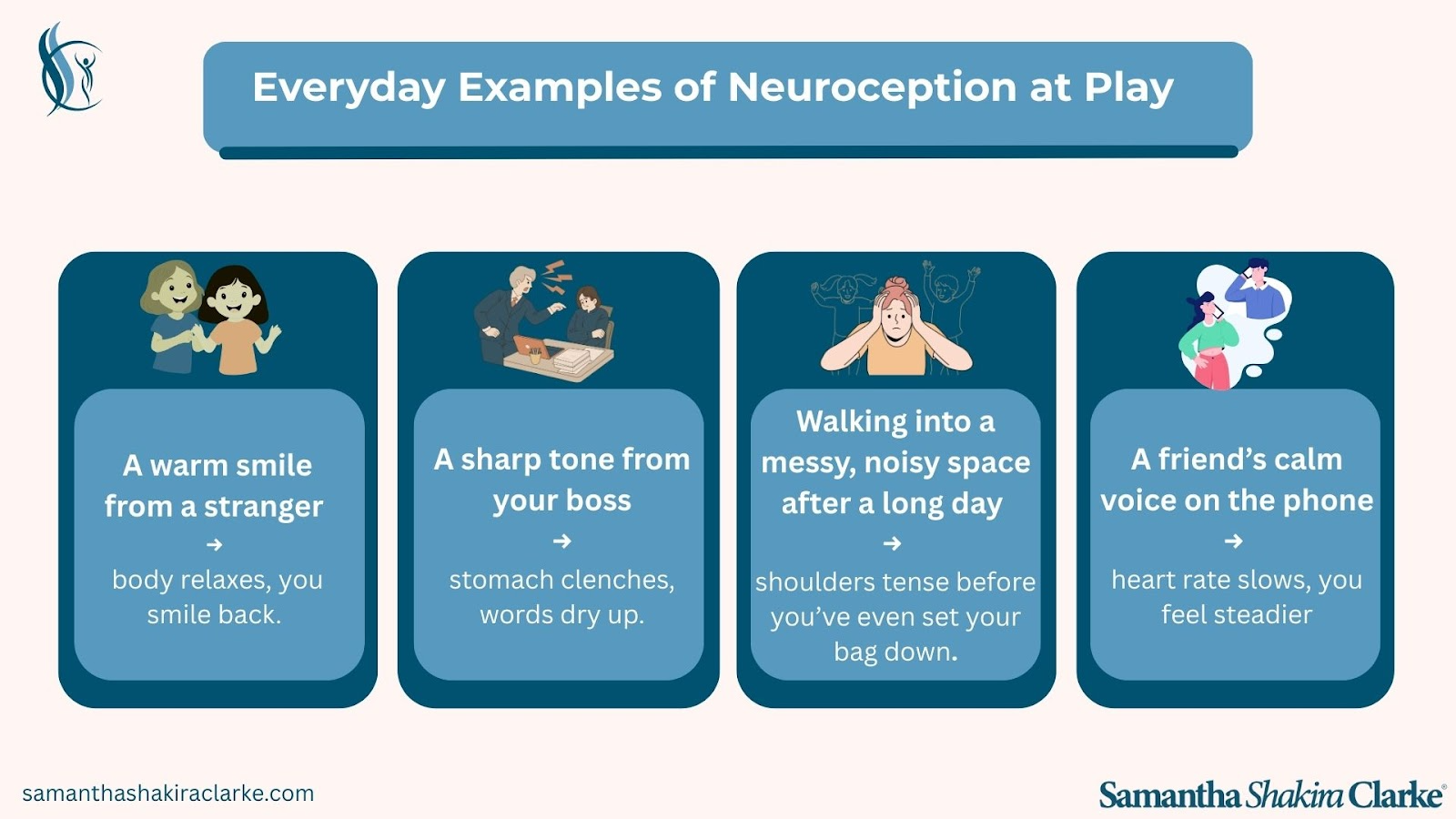 Book Now!
Book Now!Most of the time, you’re not consciously deciding whether something feels safe or threatening, your body decides for you. That’s neuroception at work.
Coined by Dr. Stephen Porges (creator of Polyvagal Theory), neuroception is your nervous system’s built-in surveillance system. It scans your environment, the people around you, and even your own internal state, looking for cues of safety, danger, or life-threat. And it does all of this before your thinking brain even gets involved.
It’s lightning fast. It’s instinctive. And it shapes how you act, think, and relate.
When your neuroception detects safety, your body can soften. Your breath deepens, your muscles release, and your brain gets access to all the good stuff, empathy, creativity, problem-solving, and connection.
When it detects a threat (real or perceived), your system shifts into fight, flight, or shutdown. Heart rate spikes or drops. Breathing changes. Your body mobilizes for protection, not collaboration.
This isn’t “overreacting.” It’s ancient biology. Once upon a time, misreading a cue could mean becoming lunch for a predator. Today, it might look like snapping at a colleague, freezing in a presentation, or feeling disconnected from your partner, even when the situation isn’t actually dangerous.
1. Your body reacts before your brain knows why
Neuroception happens faster than conscious thought, often in less than a tenth of a second. You can feel anxious, shut down, or suddenly comfortable without any clear reason.
Example: You walk into an elevator and see your boss. They glance up briefly, expression neutral, then look down at their phone. You instantly feel tense. Nothing’s been said, but your nervous system has already made a call: “Something’s off.”
2. Your nervous system listens to faces, voices, and posture more than words
A calm tone or relaxed face can regulate you faster than a perfect explanation. This is why someone saying “you’re safe” in a tense tone won’t actually make you feel safe, your body trusts nonverbal cues first.
Example: Your partner comes home and says, “Everything’s fine,” but their jaw is tight, their shoulders are hunched, and their voice is clipped. Even if the words are reassuring, your stomach knots. Your nervous system doesn’t buy it.
3. Past experiences train your present-day safety radar
Your neuroception is always scanning the present through the lens of your history. If you grew up in a loud household, raised voices might spike your stress even if the person isn’t angry. If past experiences with touch have been comforting, a hand on your shoulder might calm you, but if not, it could trigger the opposite response.
Example: You’re in a meeting and someone raises their voice to be heard over background noise. A colleague next to you doesn’t flinch. But you feel your pulse quicken and your body brace, your nervous system has linked “raised voice” with danger from long ago.

The Big Insight
Your neuroception is not always accurate in reading the present moment, but it is always truthful about the patterns your body has learned to watch for. It reflects the stress states, life experiences, and survival strategies that have shaped you.
In other words, it may misinterpret now, but it’s never lying about what your body still feels it needs to protect you from. There’s wisdom in that, even if the signal is outdated.
The good news? You can work with it.

Healthy neuroception is not just a feel-good bonus. It is measurable and meaningful. In a recent peer-reviewed study, researchers developed the Neuroception of Psychological Safety Scale (NPSS) and tested it with over 400 health and social care workers in the UK. The findings confirmed that we can reliably gauge how safe someone’s nervous system feels in a given context, and that this sense of safety is closely linked to wellbeing, trust, and performance (McGarry et al., 2021).
Knowing how to positively influence our neuroception does more than reduce stress. It transforms outcomes. Teams think more clearly, recover faster from setbacks, and take creative risks more easily.
I have seen this first-hand, many times. In one leadership retreat I facilitated, the group began in a state of subtle hyper-alertness. There were crossed arms, scanning eyes, and polite but guarded conversation. As we worked through the session, they began to notice their own nervous system states in real time. They could feel the difference between being braced and being open, and they learned how to bridge that felt sense with conscious awareness. Small shifts in breath, posture, and presence started to change the tone in the room. By the end, their body language had softened, voices carried more warmth, and conversations moved from cautious to genuinely collaborative. The change was visible and measurable in how they listened, responded, and engaged with one another.
In relationships, the same principle applies. Healthy neuroception is the difference between bracing against each other and actually hearing each other.
Neuroception is the invisible lens you’re looking through, all day, every day. Understand it, work with it, and you open the door to deeper connection, better decision-making, and a body that knows how to rest when the coast is clear.
Want to go deeper?
This is exactly what we explore in Wisdom of the Nervous System 2.0 , a session that unpacks these concepts even further and gives you practical tools to shift your state in real time. It’s ideal for keynotes, small teams, retreats, or leadership meetings. If your group could benefit from sharper thinking, calmer communication, and stronger connection, let’s talk about bringing it to you.